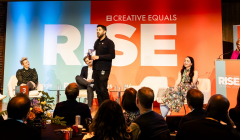
Are we leaving men and boys behind?
At Creative Equal’s RISE event, industry leaders consider how to reframe boys and men in marketing

As the climate emergency rises up the business and brand agenda, will we see a growing number of brands adopt the Greenpeace approach and recycle their advertising?

An innate tension lies within an industry that is built on consumerism and an environmental movement that demands we consume less. A tension that comes into play even before you consider the environmental impact of creating advertising in the first place.
It is a consumer and business ecosystem that makes the Rang-tan advert such a marketing moment in time, a campaign that has successfully become more than just an advert. Rang-tan is an animated Orangutan who is thrown into an unfamiliar world after her rainforest home is destroyed.
This is the first time that an advert has been wholly reused by three different brands: Greenpeace, Iceland and most-recently Dutch-supermarket Ekoplaza.
The Rang-tan spot made the headlines in the UK last year for not being cleared by UK broadcast authorities, a decision which arguably only served to increase both the buzz and online views of the advert. Iceland’s decision to forego their Christmas retail spot to share the Rang-Tan story clearly paid off. According to Kantar Millward Brown’s annual research into the effectiveness of Christmas advertising campaigns, Iceland was crowned the most powerful advert of 2018. A marketing message that was both good for the environment and good for business too.
The trend of ‘recycled advertising’ raises a number of questions for brands. At the very least it serves as a timely reminder that, at the very least, marketers often tire of their longest-running campaigns before their consumers do. But is Rang-Tan something of a marketing anomaly? A campaign which has successfully become more than just an advert because of the urgency of its environmental message.
We asked Katie Mackay-Sinclair, Partner at Mother, to lift the lid on what ‘recycled advertising’ really means for the industry.
Looks like you need to create a Creativebrief account to perform this action.
Create account Sign inLooks like you need to create a Creativebrief account to perform this action.
Create account Sign in